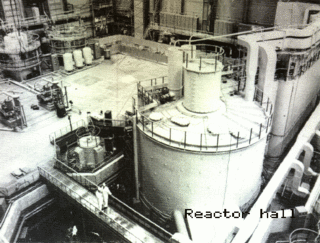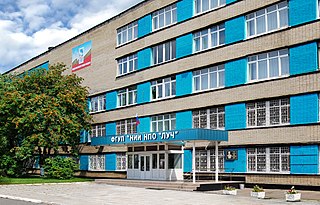
A nuclear reactor is a device used to initiate and control a fission nuclear chain reaction or nuclear fusion reactions. Nuclear reactors are used at nuclear power plants for electricity generation and in nuclear marine propulsion. Heat from nuclear fission is passed to a working fluid, which in turn runs through steam turbines. These either drive a ship's propellers or turn electrical generators' shafts. Nuclear generated steam in principle can be used for industrial process heat or for district heating. Some reactors are used to produce isotopes for medical and industrial use, or for production of weapons-grade plutonium. As of 2022, the International Atomic Energy Agency reports there are 422 nuclear power reactors and 223 nuclear research reactors in operation around the world.

A nuclear thermal rocket (NTR) is a type of thermal rocket where the heat from a nuclear reaction, often nuclear fission, replaces the chemical energy of the propellants in a chemical rocket. In an NTR, a working fluid, usually liquid hydrogen, is heated to a high temperature in a nuclear reactor and then expands through a rocket nozzle to create thrust. The external nuclear heat source theoretically allows a higher effective exhaust velocity and is expected to double or triple payload capacity compared to chemical propellants that store energy internally.

A pressurized water reactor (PWR) is a type of light-water nuclear reactor. PWRs constitute the large majority of the world's nuclear power plants. In a PWR, the primary coolant (water) is pumped under high pressure to the reactor core where it is heated by the energy released by the fission of atoms. The heated, high pressure water then flows to a steam generator, where it transfers its thermal energy to lower pressure water of a secondary system where steam is generated. The steam then drives turbines, which spin an electric generator. In contrast to a boiling water reactor (BWR), pressure in the primary coolant loop prevents the water from boiling within the reactor. All light-water reactors use ordinary water as both coolant and neutron moderator. Most use anywhere from two to four vertically mounted steam generators; VVER reactors use horizontal steam generators.

A nuclear meltdown is a severe nuclear reactor accident that results in core damage from overheating. The term nuclear meltdown is not officially defined by the International Atomic Energy Agency or by the United States Nuclear Regulatory Commission. It has been defined to mean the accidental melting of the core of a nuclear reactor, however, and is in common usage a reference to the core's either complete or partial collapse.
Kosmos is a designation given to many satellites operated by the Soviet Union and subsequently Russia. Kosmos 1, the first spacecraft to be given a Kosmos designation, was launched on 16 March 1962.

Upravlyaemy Sputnik Aktivnyy, or US-A, also known in the west as Radar Ocean Reconnaissance Satellite or RORSAT, was a series of 33 Soviet reconnaissance satellites. Launched between 1967 and 1988 to monitor NATO and merchant vessels using radar, the satellites were powered by nuclear reactors.

The Nuclear Engine for Rocket Vehicle Application was a nuclear thermal rocket engine development program that ran for roughly two decades. Its principal objective was to "establish a technology base for nuclear rocket engine systems to be utilized in the design and development of propulsion systems for space mission application". It was a joint effort of the Atomic Energy Commission (AEC) and the National Aeronautics and Space Administration (NASA), and was managed by the Space Nuclear Propulsion Office (SNPO) until the program ended in January 1973. SNPO was led by NASA's Harold Finger and AEC's Milton Klein.

A fast-neutron reactor (FNR) or fast-spectrum reactor or simply a fast reactor is a category of nuclear reactor in which the fission chain reaction is sustained by fast neutrons, as opposed to slow thermal neutrons used in thermal-neutron reactors. Such a fast reactor needs no neutron moderator, but requires fuel that is relatively rich in fissile material when compared to that required for a thermal-neutron reactor. Around 20 land based fast reactors have been built, accumulating over 400 reactor years of operation globally. The largest of this was the Superphénix Sodium cooled fast reactor in France that was designed to deliver 1,242 MWe. Fast reactors have been intensely studied since the 1950s, as they provide certain advantages over the existing fleet of water cooled and water moderated reactors. These are:

The light-water reactor (LWR) is a type of thermal-neutron reactor that uses normal water, as opposed to heavy water, as both its coolant and neutron moderator; furthermore a solid form of fissile elements is used as fuel. Thermal-neutron reactors are the most common type of nuclear reactor, and light-water reactors are the most common type of thermal-neutron reactor.
A thermionic converter consists of a hot electrode which thermionically emits electrons over a potential energy barrier to a cooler electrode, producing a useful electric power output. Caesium vapor is used to optimize the electrode work functions and provide an ion supply to neutralize the electron space charge.

The Hallam Nuclear Power Facility (HNPF) in Nebraska was a 75 MWe sodium-cooled graphite-moderated nuclear power plant built by Atomics International and operated by Consumers Public Power District of Nebraska. It was built in tandem with and co-located with a conventional coal-fired power station, the Sheldon Power Station. The facility featured a shared turbo generator that could accept steam from either heat source, and a shared control room.
A gas-cooled reactor (GCR) is a nuclear reactor that uses graphite as a neutron moderator and a gas as coolant. Although there are many other types of reactor cooled by gas, the terms GCR and to a lesser extent gas cooled reactor are particularly used to refer to this type of reactor.

The Romashka reactor was a Soviet experimental nuclear reactor. It began operation in 1964, and was developed by the Kurchatov Institute of Atomic Energy. The reactor used direct thermoelectric conversion to create electricity, rather than heating water to drive a turbine. It is thus similar to a radioisotope thermoelectric generator, but higher power.
Krasnaya Zvezda State Enterprise is a Russian state enterprise that researches and produces nuclear power systems for spacecraft. It was established in 1972, is located in Moscow and is subordinated to Rosatom.
Kosmos 1818 was a nuclear powered Soviet surveillance satellite in the RORSAT program, which monitored NATO vessels using radar. Kosmos 1818 was the first satellite to use the TOPAZ-1 fission reactor. In July 2008, the satellite was damaged, and leaked a trail of sodium coolant.
Kosmos 1867 is a nuclear powered radar ocean reconnaissance satellite (RORSAT) that was launched by the Soviet Union on July 10, 1987. It was put into an orbit of about 800 km (500 mi). Its mission was to monitor the oceans for naval and merchant vessels, and had a mission life of about eleven months.

Project Rover was a United States project to develop a nuclear-thermal rocket that ran from 1955 to 1973 at the Los Alamos Scientific Laboratory (LASL). It began as a United States Air Force project to develop a nuclear-powered upper stage for an intercontinental ballistic missile (ICBM). The project was transferred to NASA in 1958 after the Sputnik crisis triggered the Space Race. It was managed by the Space Nuclear Propulsion Office (SNPO), a joint agency of the Atomic Energy Commission (AEC), and NASA. Project Rover became part of NASA's Nuclear Engine for Rocket Vehicle Application (NERVA) project and henceforth dealt with the research into nuclear rocket reactor design, while NERVA involved the overall development and deployment of nuclear rocket engines, and the planning for space missions.

Nuclear power in space is the use of nuclear power in outer space, typically either small fission systems or radioactive decay for electricity or heat. Another use is for scientific observation, as in a Mössbauer spectrometer. The most common type is a radioisotope thermoelectric generator, which has been used on many space probes and on crewed lunar missions. Small fission reactors for Earth observation satellites, such as the TOPAZ nuclear reactor, have also been flown. A radioisotope heater unit is powered by radioactive decay and can keep components from becoming too cold to function, potentially over a span of decades.

BES-5, also known as Bouk or Buk, was a Soviet thermoelectric generator that was used to power 31 satellites in the US-A (RORSAT) project. The heat source was a uranium 235 fast fission nuclear reactor (FNR).

Luch Scientific Production Association or NPO Luch is a company based in Podolsk, Russia. It is part of Rosatom.














